Haystack Observatory
Haystack Observatory is an interdisciplinary research center located in Westford, MA, some 40 miles northwest of the MIT campus. The observatory conducts astronomical studies using radio techniques, geodetic measurements using Very Long Baseline Interferometry (VLBI), and atmospheric observations using high-power incoherent scatter radar. A strong instrumentation development program is conducted at Haystack Observatory to support the various scientific research programs.
The radio astronomy research program is carried out under the auspices of the Northeast Radio Observatory Corporation (NEROC), a consortium of ten educational and research institutions in the northeast that includes Boston University, Brandeis University, Dartmouth College, Harvard University, MIT, the Smithsonian Astrophysical Observatory, University of Massachusetts, University of New Hampshire, Wellesley College, and Yale University. The current priority of the radio astronomy program at Haystack is the development of a Low Frequency Array (LOFAR) for the study of the structure of our galaxy, the early Universe, and transient astronomical events.
The primary objective of the geodetic VLBI research program is to improve the accuracy of measurements of Earth's orientation parameters by enhancing the bandwidth of the observations through high data-rate recording on magnetic disks and through the development of protocols for the transport of wideband data on fiber networks. The current goal of the atmospheric science program is to understand the impact of solar disturbances on the Earth's upper atmosphere using radar measurements at Millstone Hill.
An important component of the observatory's mission is to support the training of students by providing opportunities for them to link their education with research through the disciplines practiced at the observatory. Access to the observatory's telescopes is provided for educational purposes and special instrumentation is developed for introducing students to radio astronomy and radio science techniques. In addition, internship opportunities are made available to graduate and undergraduate students and to local area science teachers.
The observatory receives financial support primarily from federal agencies including the National Science Foundation (NSF), the National Aeronautical and Space Administration (NASA), and the Department of Defense, as well as from industrial sources.
Instrumentation
The Haystack Observatory instrumentation consists of the following facilities:
- A 37-m diameter radio telescope used for astronomical observations and for radar measurements
- An 18-m diameter radio telescope involved in VLBI measurements of the Earth's rotation parameters
- An 8-station wideband VLBI correlator used to process global geodetic and astronomical observations
- A 2.5 MW UHF radar that utilizes two large antennas, 46 m and 67 m in diameter, to study the Earth's upper atmosphere using incoherent backscatter techniques, augmented by passive optical telescopes
Radio Astronomy
The Low Frequency Array (LOFAR) will consist of 100 antenna stations, inter-connected through optical fiber and distributed over 400 km. The array will operate in the 10-240 MHz frequency range, and will be the first fully digital radio telescope capable of observing with multiple independent beams. With its unprecedented sensitivity, it will allow the detection of radio sources at the milli-Jansky level with arc-second resolution. The project is led at Haystack by Dr. Colin Lonsdale, and collaborators include Dr. Roger Cappallo and Dr. Sheperd Doeleman, and Professor Jacqueline Hewitt of the MIT Center for Space Research and the Department of Physics. The scientific projects of interest to the MIT and Haystack astronomers involve measurements of the structure of the Universe at the early epoch of reionization and detection of astronomical transients such as gamma ray bursts through their radio emission. Design work at MIT and Haystack, funded under a grant from NSF, has progressed during the past year in three main areas: an all-sky monitor has been designed for detecting transient events; a simulator has been developed to assess the various array design options and test the effectiveness of the calibration system, and a prototype antenna covering the LOFAR upper frequency band (110-240 MHz) has been designed and tested. In addition, Haystack researchers have supported the array's signal processing design, in collaboration with partners at the Netherlands Foundation for Radio Astronomy (ASTRON) and at the Naval Research Laboratory (NRL).
We are pleased to report the award of a grant from NSF for the study of coronal mass ejections (CME) from the Sun using LOFAR. This project, a collaboration between Haystack Observatory and the Center for Space Research, will investigate the capabilities of LOFAR to use interplanetary scintillations in order to map the plasma structures in the solar wind that impinge on Earth's magnetosphere and ionosphere and cause space weather effects. These effects can disrupt radio communications, jeopardize satellite electronics, and affect satellite orbits in space as well as power grids on Earth. In particular, our group will study the feasibility of determining the magnetic field strength and orientation in a CME using LOFAR, since the geoeffectiveness of a CME is dependent on how well its magnetic field couples with the Earth's magnetosphere.
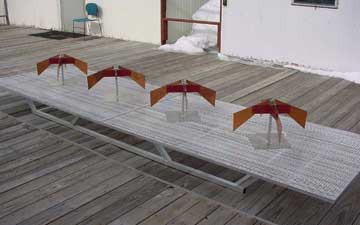 Prototype LOFAR antennas covering the 110–240 MHz frequency band |
Haystack Observatory has also been actively involved, together with the LOFAR partner institutions, in finding the best site for locating LOFAR. Three candidate sites are currently being evaluated: the southwest US, the Netherlands, and Western Australia. The driving technical criterion is the level of radio frequency interference at the low frequencies that LOFAR must operate, particularly in the long term. Measurements have been taken at the three sites and are currently under analysis and review. It is expected that a decision regarding the site will be made in early fall 2003.
Another project at Haystack is aimed at the development of a multibeam array operating at 327 MHz for the detection of Deuterium—a most sensitive indicator of the density of baryons that relates to the amount of dark matter in the Universe. Detection of the Deuterium line at its radio frequency has been elusive due to the inadequate sensitivity of available telescopes. The project, funded by the NSF, is led by Dr. Alan Rogers. A very sensitive digital receiver has been designed and a dipole antenna array consisting of 32 stations is being constructed at the Observatory in Westford. Major effort continues to be expended on characterizing the radio frequency interference environment at 327 MHz around the MIT site in Westford and mitigating the effects through various approaches. It is expected that the construction will be completed by the end of 2003, and measurements to detect the Deuterium line will be initiated in early 2004.
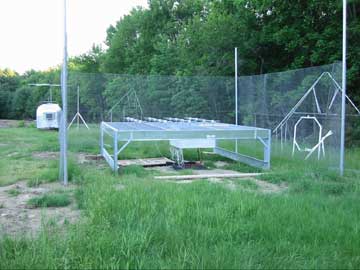 Prototype station for the Deuterium Array, with 25 dual-polarization antennas |
A successful astronomical VLBI experiment was conducted in April 2003 using an array of four radio telescopes operating at 1.3 and 2 mm wavelength, including two mountain-top telescopes in Arizona and two in the Alps in the Europe. The experiment was led by Dr. Shep Doeleman of Haystack in collaboration with scientists at the University of Arizona, at the Max Planck Institute in Germany, and at the University of Grenoble. In addition to the detection of interferometric fringes on radio emission from silicon monoxide masers at 127 GHz in various stellar sources, fringes were detected for the first time across the Atlantic at 230 GHz. This set a new record of angular resolution at ~ 30 micro-arcsecond achieved by VLBI using active galactic nuclei as sources of radio emission. The results were enabled by the application of Haystack's advanced technology for recording the data at rates of 1 Gbits/s at all telescopes, thus enhancing the sensitivity of the experiment compared to previous attempts. Application of this advanced technology using large telescopes at centimeter wavelengths, such as Arecibo, Green Bank, and Effelsberg, Germany, is similarly expected to further expand the study by Colin Lonsdale and collaborators of star formation in luminous infrared galaxies such as Arp 220, where roughly 30 radio supernovae associated with an intense nuclear starburst were detected in a recent experiment.
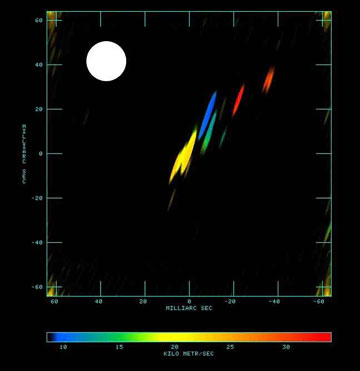 First VLBI map obtained at 2-mm wavelength showing the location of SiO maser emission in the stellar source VY CMa |
Instrumentation Development
Haystack's Mark 5 recording system at 1 Gbit/s noted above was developed under the leadership of Dr. Alan Whitney, and most telescopes participating in geodetic and astronomical VLBI networks are now adapting the technology. The system is based on magnetic-disk recording, and is now available commercially through Conduant Corporation, CO. During the past year, as many as 35 Mark 5 units were deployed at telescopes around the world and at VLBI correlators for data playback and processing. The system is now being used on a routine basis for earth orientation measurements. In addition to enhanced bandwidth of the recorded data, the Mark 5 system is more reliable and easier to maintain than the Mark 4 tape-based system and is much less expensive to purchase. Haystack researchers plan to continue further improvements to the Mark 5 system and to exploit the new technology for various innovative applications in the future.
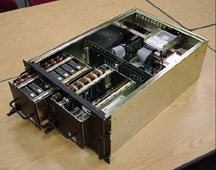 Mark 5 magnetic disk recording system |
Haystack Observatory is also leading a major development for VLBI data acquisition and transport using wideband fiber optic networks within the US and globally. Initial successful demonstration experiments were completed during the past year between telescopes at Haystack and at Goddard Space Flight Center by a team led by Dr. Alan Whitney, using seed funding from DARPA and NASA. The 'e-VLBI' development team includes Dr. John Wroclauski of the Laboratory for Computer Sciences and Dr. Steven Bernstein of Lincoln Laboratory, and the scope of the project has been expanded to the development of protocols that allow the sharing of the fiber networks with other applications on a non-interference basis. A new grant was received during the past year from the NSF to support this development and to conduct tests of real-time data acquisition with telescopes in Hawaii, Japan, and Europe. The advantages of e-VLBI, in addition to bypassing data recording in the longer term, include the expansion of signal bandwidth and sensitivity of experiments beyond that achievable by data recording, and the rapid confirmation of the set-up of experiments in order to correct problems promptly. In addition, there are some applications such as earth orientation measurements for navigation, where the latency of the observations can be reduced dramatically through rapid turn-around of the data processing.
Finally, it is worth noting that Haystack Observatory has completed in the past year all the hardware development in support of the Smithsonian Institution's Submillimeter Array (SMA). All correlator boards have been delivered, as well as digital boards for the down-converter system. This ends a very productive and successful collaboration with the Smithsonian Astrophysical Observatory that started nearly ten years ago. The Smithsonian has also completed the assembly of its various antenna mounts at an assembly building constructed for this purpose by the Smithsonian at the MIT site in Westford, and the building is now expected to become part of the Haystack Observatory facilities.
Atmospheric Science
An important scientific highlight of the observatory's research program in the physics of the Earth's upper atmosphere during the past year has involved the tracing of a plume of enhanced plasma from its source in the Earth's magnetosphere into the ionosphere at middle latitudes. This plume was identified by Dr. John Foster and Dr. Anthea Coster of Lincoln Laboratory using ionospheric electron content measurements from a global GPS array during a geomagnetic storm, and has been confirmed with the Millstone Hill incoherent scatter radar and the NASA IMAGE satellite. The measurements indicate the value of ground-based data to study the coupling of the magnetosphere with the ionosphere, with implications for space weather studies at mid-latitudes. As a result of this work, Dr. Foster and colleagues have been awarded a new grant from NASA to pursue this work and connect with NASA's 'Living with a Star' program.
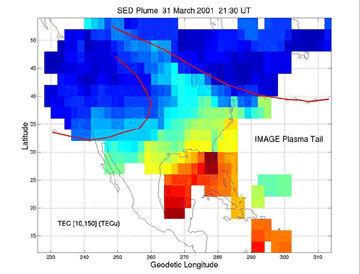 Plume of ionization observed during a geomagnetic storm event using a GPS network of receivers |
MIT's cooperative agreement with NSF for operations of the Millstone Hill ionospheric radar has been renewed for another five-year period. This will support the continuation of the research work in the Observatory's atmospheric sciences group and the development of the necessary radar instrumentation. Included in this development will be the replacement of the data acquisition system with a work-station based system, structural improvements to the 150-ft steerable antenna and its foundation, and the adaptation of the UHF transmitter to use newly acquired high-power klystron tubes obtained from a decommissioned Air Force facility.
Finally, authorization by NSF to begin construction of a relocatable atmospheric radar to study the high-latitude ionosphere has been received. The Haystack group, under Dr. John Holt's leadership, will contribute to the development of the data acquisition and data base system for this new radar. The overall project to design and build this phased array radar is led by SRI International and involves several university groups. The plan is to construct a prototype system in Alaska and then move the radar to the polar cap region and other locations as needed for scientific observations.
Educational Programs
Strengthening undergraduate education through research in radio astronomy using the facilities of the Haystack Observatory continues under a newly-awarded grant from the NSF. The new effort involves expansion of the capabilities of the Small Radio Telescope (SRT) designed at Haystack and commercialized through CASSI, Inc., providing access to the Haystack 37-m telescope for education, and development of additional educational materials and their dissemination through the World Wide Web. The main emphasis in expanding the SRT capabilities will be on introducing radio interferometry to undergraduates, using either two SRTs, or one SRT and a simpler and less costly Yagi antenna.
We are pleased to report that the concept of the SRT as an educational tool has been widely adopted at many colleges and universities. There are currently ~80 SRTs distributed in the US and around the world, and we continue to receive good comments from users of this educational instrument. We expect that the radio interferometry project will further enhance the SRT's utility and will provide students with another challenging educational research opportunity.
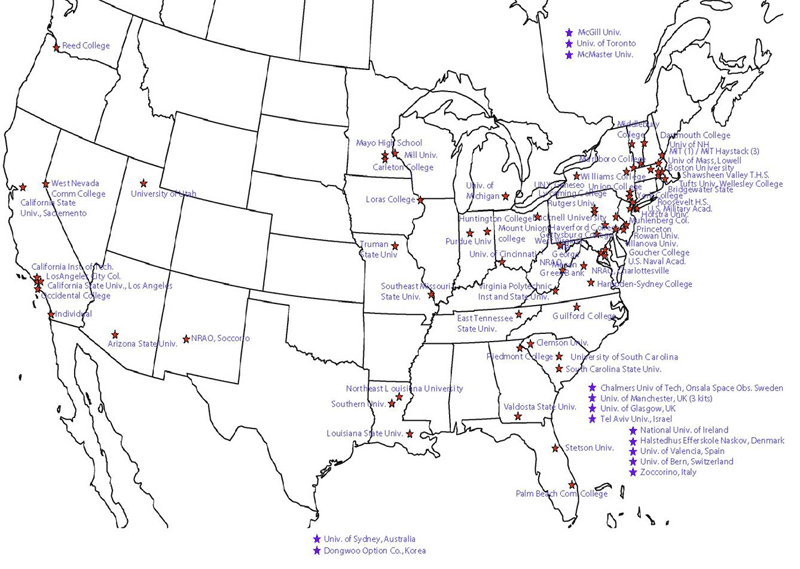 Location of Small Radio Telescopes at colleges and universities, as of May 2003 |
Finally, Haystack's Research Experiences for Undergraduates (REU) program continued in the past year with the support of internships for 10 students at the observatory. The students work on research projects such as LOFAR, VLBI, and atmospheric radar with members of the Haystack staff. Outreach to pre-college teachers has also continued through the Research Experiences for Teachers (RET) program, which provides internships to local area science teachers. Four teachers were engaged in the past year in projects associated with the research disciplines of the Observatory, and worked with our staff to introduce new science concepts into their classes. Some of the projects included measurements of solar radio emission using the SRT and the mapping of radio interference in the local area.
More information about the Haystack Observatory research and education programs can be found on the web at http://www.haystack.mit.edu/.